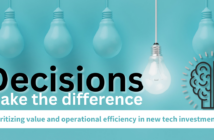Manufacturers have made great advancements in technology, both in efficiency and operations monitoring.
By Randy F. Radtke
Take a moment to think about how much you interact with technology during your day. It’s probably so much so, that you can’t even imagine what it was like to operate your property without it. Let’s face it; without a full-featured property management system (PMS) alone, hotel management would look dramatically different.
Technology, however, doesn’t stop there. It’s likely integrated into HVAC systems, camera systems and in maintenance. So how about the laundry? Chances are it’s not the first area that comes to mind when thinking about hotel technology. But why? Arguably, no other department has a greater impact on the guest experience than the laundry. All those amenities your hotel offers won’t mean much if sheets and pillow cases don’t have a high quality look and feel. Perhaps it’s time to take a look at technology in the laundry that can ensure quality results and high efficiency, both in labor and utilities.
The wash side basics
Washer-extractor technology has changed dramatically over the years, yet many hotels are still operating with old, inefficient machines. Laundries that haven’t upgraded washers to ultra-high G-force (300 G-force and higher) are severely handicapping their operations with longer drying times and greater utility expenses.
The difference between 400 G-force and 100 G-force can be roughly $1,000 in gas savings per year, based on the reduced drying time. Ultra-high extraction speeds remove significantly more water from loads, which in turn cuts drying times and utility consumption. Today’s modern inverter drives reduce electrical consumption by 40 percent through gradually ramping the machine up to the high spin speed.
It’s also easier to achieve that high extraction speed with more sensitive out-of-balance technology. In the past, often washers would struggle to hit the maximum extraction speed, if loads were just a bit out of balance. Upgraded technology has largely eliminated that condition in some models.
Programmability is another feature that technology has brought to the laundry. Properties make a significant investment in linens, so keeping them looking good and getting the maximum lifespan out of them is paramount.
“Today’s modern washer-extractors are giving laundry managers complete control over every step of the wash process,” said Bill Brooks, North American sales manager of UniMac. “Advanced programmability enables the manager and laundry chemical supplier to work together and tailor each cycle to the specific linen type and soil level,” he said. This results in excellent finished results, lower reject/rewash rates and longer linen life.
In addition, some of today’s controls have displays showing cycle names, versus old technology, where operators punched in a code. Many even offer multiple language options for bilingual staff.
The dry side basics
On the drying side, manufacturers have made great advancements. While programmable controls have led the way, moisture sensing has made the greatest impact on bottom lines.
In the past, operators cranked that old dial control to the maximum dry time to make certain the load would be dry when they returned, and they wouldn’t have to add extra time. We now know that over-drying, by even just eight minutes, is costly. A property processing 10 loads per day would waste about $883 in utilities and $4,866 in labor each year if over-drying by 8 minutes.
Moisture-sensing technology removes that waste. Loads are dried to a preset moisture level and the tumble dryer stops. An additional benefit is extended linen life, as over-drying linens degrades them faster. Those eight minutes of over-drying can reduce linen life by 33 percent.
Next-level technology
Networking and cloud-based solutions are likely a part of many systems at hotel properties. Well, that technology has now made its way into the laundry room.
“For years, the laundry has been a cost center that management had little to no visibility to,” Brooks said. “Technology is changing that and giving them tools to better understand the cost structure and where the inefficiency lurks.”
Laundry management systems can provide a wealth of information with reports on machine diagnostics, utilization and expenses. Some cloud-based solutions are even able to offer real-time views into the operation and break down expenses to give a total cost per pound to process laundry. This is especially helpful for owners of multiple properties, so they can compare all their laundries to see which ones are measuring up and which ones need work.
“I like to tell hotel owners that you can’t improve what you can’t measure,” Brooks said. “Laundry technology has finally advanced to a point where you can monitor the performance of the operation and easily identify any issues.”
Access to that advanced data can drive a variety of actions to correct issues, beyond just utility efficiency. Jim Calverley, sales manager at Coronet Equipment Ltd., recounts one example from a hotel in his area. Here, a hotel general manager who reviewed operations reports noticed that the laundry’s unsupervised second shift was significantly less productive than the first shift, which is supervised.
“The conversation with staff is markedly different when management can present data that proves an issue exists,” Calverley said. “And with labor being the largest expense in running a laundry, savings can be significant.”
Likewise, management needs to know staff is following prescribed processes. These advanced systems can help managers identify when staff needs additional training.
Final thoughts
Great improvements have been made, both in efficiency and operations monitoring. However, it’s up to each property to determine what level of technology is a fit for their business. For most hotels, focusing on reducing operating costs through better efficiency is a good start. Larger properties and groups managing multiple properties will want to add a higher level of technology that helps ensure greater accountability.
“When you look at the cost of today’s equipment, I think it’s imperative for large hotels and ownership groups to have systems in place to monitor operations in order to identify training opportunities,” Brooks said. “Altering of processes is the biggest threat to the efficiency of equipment and the overall laundry. This is why laundry management systems that track productivity, as well as overall costs, are becoming a must-have.”
Staff that receives adequate training will perform better, deliver a higher level of productivity and be happier about the work they perform, which should help curb the turnover trend that laundries often face.
Like any technology, it’s not just about collecting data. Management needs to be committed to using the information to ask questions and fine-tune processes where necessary to reduce costs and improve quality. ■
Randy F. Radtke is global public relations manager at Alliance Laundry Systems, a world leader in manufacturing commercial laundry equipment. To learn more, visit www.alliancelaundry.com.




